Working Outside of the System: Social Movements and Activism
Author’s Note
We’ve spent a large portion of this chapter focused on historical and current aspects of the way social processes work in this country: the census, voting, representation, the courts and elected officials. We have attempted to uncover some of the flaws, gaps, and structures that lead to unequal representation and treatment of families. Change within these processes is possible, but sometimes challenging because the existing structures favor some groups and reinforce negative bias and inequality toward others. Working outside of the systems to push for change is an alternative for people whom the systems have marginalized.
With the exception of brief introductory paragraphs, this section is drawn from two other openly licensed texts, demonstrating the power of shared resources.
–Elizabeth B. Pearce
Social Movements
A social movement may be defined as an organized effort by a large number of people to bring about or impede social, political, economic, or cultural change. Defined in this way, social movements might sound similar to special-interest groups, and they do have some things in common. But a major difference between social movements and special-interest groups lies in the nature of their actions. Special-interest groups normally work within the system via conventional political activities such as lobbying and election campaigning. In contrast, social movements often work outside the system by engaging in various kinds of protest, including demonstrations, picket lines, sit-ins, and sometimes outright violence.
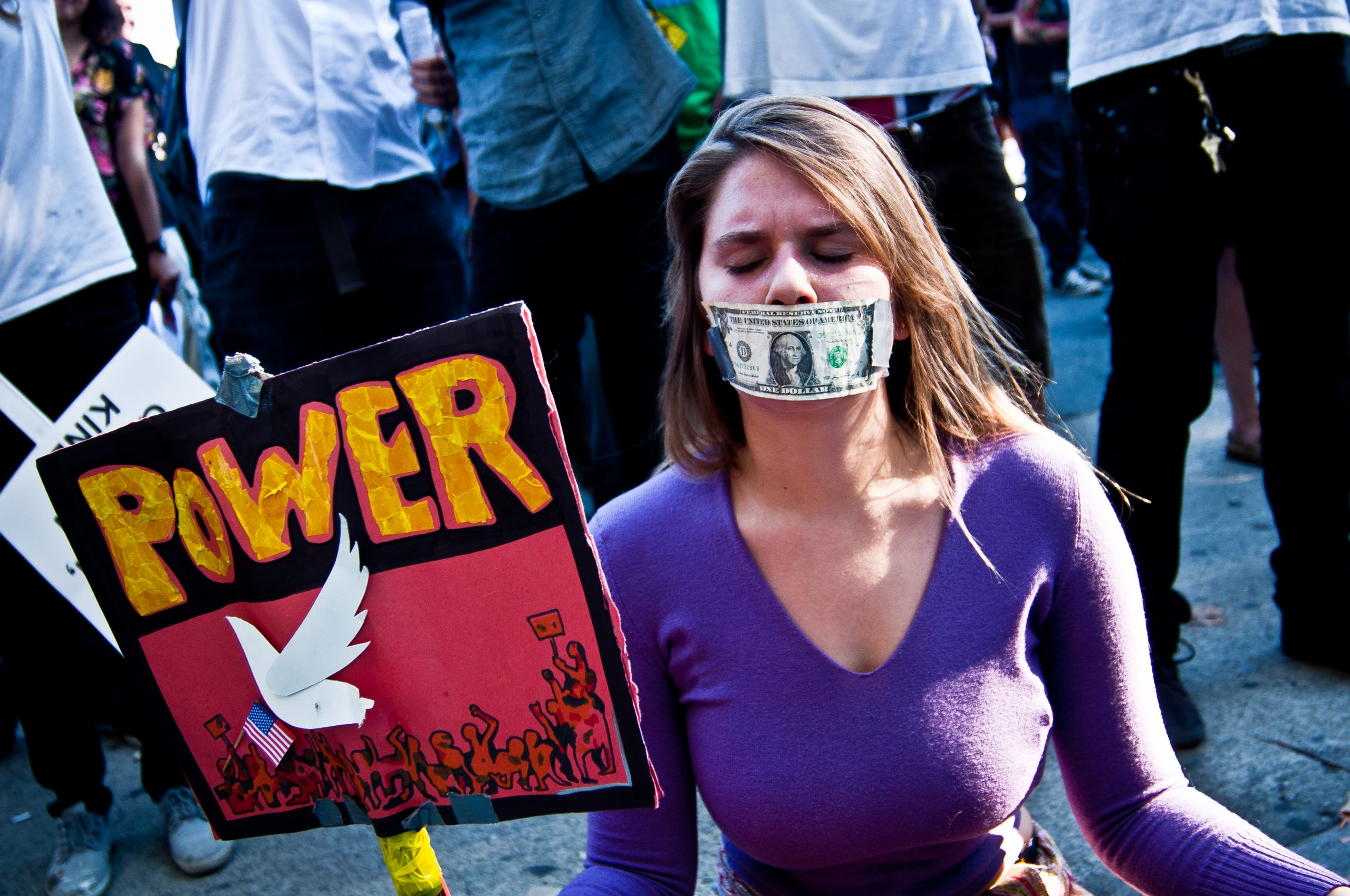
Conceived in this way, the efforts of social movements amount to “politics by other means,” with these “other means” made necessary because movements lack the resources and access to the political system that interest groups typically enjoy.[1]
Sociologists identify several types of social movements according to the nature and extent of the change they seek. This typology helps us understand the differences among the many kinds of social movements that existed in the past and continue to exist today.[2]
One of the most common and important types of social movements is the reform movement, which seeks limited, though still significant, changes in some aspect of a nation’s political, economic, or social systems. It does not try to overthrow the existing government but rather works to improve conditions within the existing regime. Some of the most important social movements in U.S. history have been reform movements. These include the abolitionist movement preceding the Civil War, the women’s suffrage movement that followed the Civil War, the labor movement, the Southern civil rights movement, the Vietnam era’s antiwar movement, the contemporary women’s movement, the gay rights movement, and the environmental movement.
A revolutionary movement goes one large step further than a reform movement in seeking to overthrow the existing government and to bring about a new one and even a new way of life. Revolutionary movements were common in the past and were responsible for dramatic changes in Russia, China, and several other nations. Reform and revolutionary movements are often referred to as political movements because the changes they seek are political in nature.
Another type of political movement is the reactionary movement, so named because it tries to block social change or to reverse social changes that have already been achieved. The antiabortion movement is a contemporary example of a reactionary movement, as it arose after the U.S. Supreme Court legalized most abortions in Roe v. Wade (1973) and seeks to limit or eliminate the legality of abortion.
In Focus: Feminism and Intersectionality
While many social movements deserve attention, we would like to focus here on one social movement that emphasizes a key theme of this text: our multiple social identities and intersectionality. Women are 51% of the population in the United States[3] and have advocated for over 100 years for equality. The in-depth essay that follows is an excerpt from the text Introduction to Women, Gender, and Sexuality Studies authored by Miliann Kang, Donovan Lessard, and Laura Heston at the University of Massachusetts, Amherst. I am very grateful to be able to use this analysis to illustrate the importance of and the It illustrates the complexity working toward equity while focused on one social characteristic (in this case, being female). How does this social movement navigate the intersections of race, ethnicity, parenthood, employee status, and sexuality? By studying the feminist movement over time, we can see the multiple dimensions, weaknesses, and strengths of communities advocating for change.
Introduction: Feminist Movements
“History is also everybody talking at once, multiple rhythms being played simultaneously. The events and people we write about did not occur in isolation but in dialogue with a myriad of other people and events. In fact, at any given moment millions of people are all talking at once. As historians we try to isolate one conversation and to explore it, but the trick is then how to put that conversation in a context which makes evident its dialogue with so many others—how to make this one lyric stand alone and at the same time be in connection with all the other lyrics being sung.”
—Elsa Barkley Brown, “’What has happened here,’” pp. 297-298.
Feminist historian Elsa Barkley Brown reminds us that social movements and identities are not separate from each other, as we often imagine they are in contemporary society. She argues that we must have a relational understanding of social movements and identities within and between social movements—an understanding of the ways in which privilege and oppression are linked and how the stories of people of color and feminists fighting for justice have been historically linked through overlapping and sometimes conflicting social movements. In this chapter, we use a relational lens to discuss and make sense of feminist movements, beginning in the 19th Century up to the present time. Although we use the terms “first wave,” “second wave,” and “third wave,” characterizing feminist resistance in these “waves” is problematic, as it figures distinct “waves” of activism as prioritizing distinct issues in each time period, obscuring histories of feminist organizing in locations and around issues not discussed in the dominant “waves” narratives. Indeed, these “waves” are not mutually exclusive or totally separate from each other. In fact, they inform each other, not only in the way that contemporary feminist work has in many ways been made possible by earlier feminist activism, but also in the way that contemporary feminist activism informs the way we think of past feminist activism and feminisms. Nonetheless, understanding that the “wave” language has historical meaning, we use it throughout this section. Relatedly, although a focus on prominent leaders and events can obscure the many people and actions involved in everyday resistance and community organizing, we focus on the most well known figures, political events, and social movements, understanding that doing so advances one particular lens of history.
Additionally, feminist movements have generated, made possible, and nurtured feminist theories and feminist academic knowledge. In this way, feminist movements are fantastic examples of praxis—that is, they use critical reflection about the world to change it. It is because of various social movements—feminist activism, workers’ activism, and civil rights activism throughout the 19th, 20th, and 21st centuries—that “feminist history” is a viable field of study today. Feminist history is part of a larger historical project that draws on the experiences of traditionally ignored and disempowered groups (e.g., factory workers, immigrants, people of color, lesbians) to re-think and challenge the histories that have been traditionally written from the experiences and points of view of the powerful (e.g., colonizers, representatives of the state, the wealthy)—the histories we typically learn in high school textbooks.
19th Century Feminist Movements
What has come to be called the first wave of the feminist movement began in the mid 19th century and lasted until the passage of the 19th Amendment in 1920, which gave women the right to vote. White middle-class first wave feminists in the 19th century to early 20th century, such as suffragist leaders Elizabeth Cady Stanton and Susan B. Anthony, primarily focused on women’s suffrage (the right to vote), striking down coverture laws, and gaining access to education and employment. These goals are famously enshrined in the Seneca Falls Declaration of Sentiments, which is the resulting document of the first women’s rights convention in the United States in 1848.
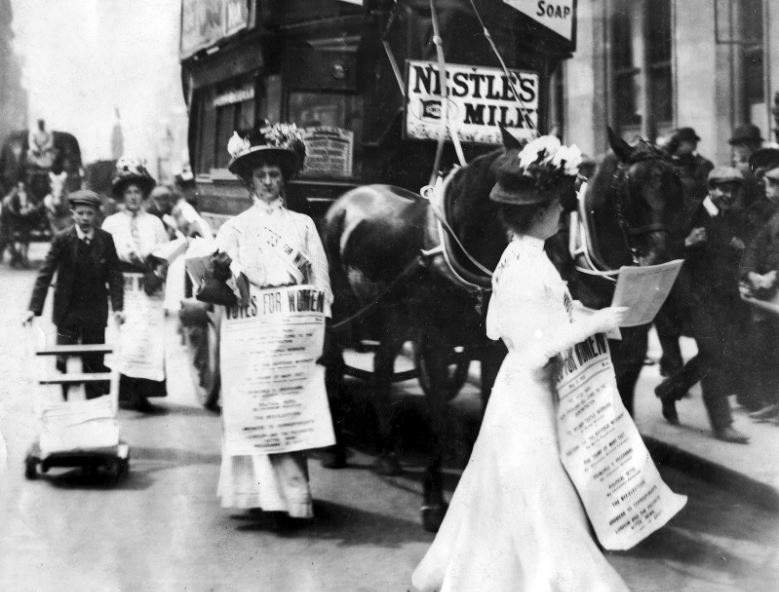
Demanding women’s enfranchisement, the abolition of coverture, and access to employment and education were quite radical demands at the time. These demands confronted the ideology of the cult of true womanhood, summarized in four key tenets—piety, purity, submission and domesticity—which held that White women were rightfully and naturally located in the private sphere of the household and not fit for public, political participation or labor in the waged economy. However, this emphasis on confronting the ideology of the cult of true womanhood was shaped by the White middle-class standpoint of the leaders of the movement. As we discussed in Chapter 3, the cult of true womanhood was an ideology of White womanhood that systematically denied Black and working-class women access to the category of “women,” because working-class and Black women, by necessity, had to labor outside of the home.
The White middle-class leadership of the first wave movement shaped the priorities of the movement, often excluding the concerns and participation of working-class women and women of color. For example, Elizabeth Cady Stanton and Susan B. Anthony formed the National Women Suffrage Association (NWSA) in order to break from other suffragists who supported the passage of the 15th Amendment, which would give African American men the right to vote before women. Stanton and Anthony privileged White women’s rights instead of creating solidarities across race and class groups. Accordingly, they saw women’s suffrage as the central goal of the women’s rights movement. For example, in the first issue of her newspaper, The Revolution, Susan B. Anthony wrote, “We shall show that the ballot will secure for woman equal place and equal wages in the world of work; that it will open to her the schools, colleges, professions, and all the opportunities and advantages of life; that in her hand it will be a moral power to stay the tide of crime and misery on every side.”[4] Meanwhile, working-class women and women of color knew that mere access to voting did not overturn class and race inequalities. As feminist activist and scholar Angela Davis writes, working-class women “…were seldom moved by the suffragists’ promise that the vote would permit them to become equal to their men—their exploited, suffering men.”[5] Furthermore, the largest suffrage organization, the National American Woman Suffrage Association (NAWSA)—a descendent of the National Women Suffrage Association—barred the participation of Black women suffragists in its organization.
Although the first wave movement was largely defined and led by middle class White women, there was significant overlap between it and the abolitionist movement—which sought to end slavery—and the racial justice movement following the end of the Civil War. Historian Nancy Cott[6] argues that, in some ways, both movements were largely about having self-ownership and control over one’s body. For enslaved people, that meant the freedom from lifelong, unpaid, forced labor, as well as freedom from the sexual assault that many enslaved Black women suffered from their masters. For married White women, it meant recognition as people in the face of the law and the ability to refuse their husbands’ sexual advances. White middle-class abolitionists often made analogies between slavery and marriage, as abolitionist Antoinette Brown wrote in 1853 that, “The wife owes service and labor to her husband as much and as absolutely as the slave does to his master.”[7] This analogy between marriage and slavery had historical resonance at the time, but it problematically conflated the unique experience of the racialized oppression of slavery that African American women faced with a very different type of oppression that White women faced under coverture. This illustrates quite well Angela Davis’[8] argument that while White women abolitionists and feminists of the time made important contributions to anti-slavery campaigns, they often failed to understand the uniqueness and severity of enslaved women’s lives and the complex system of chattel slavery.
Black activists, writers, newspaper publishers, and academics moved between the racial justice and feminist movements, arguing for inclusion in the first wave feminist movement and condemning slavery and Jim Crow laws that maintained racial segregation. Sojourner Truth’s famous “Ain’t I a Woman?” speech, which has been attributed to the Akron Women’s Convention in 1851, captured this contentious linkage between the first wave women’s movement and the abolitionist movement well. In her speech, she critiqued the exclusion of Black women from the women’s movement while simultaneously condemning the injustices of slavery:
That man over there says that women need to be helped into carriages, and lifted over ditches, and to have the best place everywhere. Nobody ever helps me into carriages, or over mud-puddles, or gives me any best place! And ain’t I a woman? Look at me! Look at my arm! I have ploughed and planted, and gathered into barns, and no man could head me!….I have borne thirteen children, and seen most all sold off to slavery, and when I cried out with my mother’s grief, none but Jesus heard me! And ain’t I a woman?
Feminist historian Nell Painter[9] has questioned the validity of this representation of the speech, arguing that White suffragists dramatically changed its content and title. This illustrates that certain social actors with power can construct the story and possibly misrepresent actors with less power and social movements.
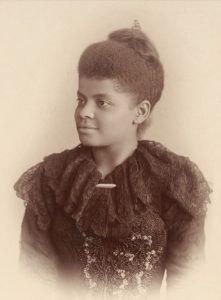
Despite their marginalization, Black women emerged as passionate and powerful leaders. Ida B. Wells , a particularly influential activist who participated in the movement for women’s suffrage, was a founding member of the National Association of the Advancement of Colored People (NAACP), a journalist, and the author of numerous pamphlets and articles exposing the violent lynching of thousands of African Americans in the Reconstruction period (the period following the Civil War). Wells argued that lynching in the Reconstruction Period was a systematic attempt to maintain racial inequality, despite the passage of the 14th Amendment in 1868 (which held that African Americans were citizens and could not be discriminated against based on their race).[10] Additionally, thousands of African American women were members of the National Association of Colored Women’s Clubs, which was pro-suffrage, but did not receive recognition from the predominantly middle-class, White National American Woman Suffrage Association (NAWSA).
The passage of the 19th Amendment in 1920 provided a test for the argument that the granting of women’s right to vote would give them unfettered access to the institutions they had been denied from, as well as equality with men. Quite plainly, this argument was proven wrong, as had been the case with the passage of the 18th Amendment followed by a period of backlash. The formal legal endorsement of the doctrine of “separate but equal” with Plessy v. Ferguson in 1896, the complex of Jim Crow laws in states across the country, and the unchecked violence of the Ku Klux Klan, prevented Black women and men from access to voting, education, employment, and public facilities. While equal rights existed in the abstract realm of the law under the 18th and 19th amendments, the on-the-ground reality of continued racial and gender inequality was quite different.
Early to Late 20th Century Feminist Movements
Social movements are not static entities; they change according to movement gains or losses, and these gains or losses are often quite dependent on the political and social contexts they take place within. Following women’s suffrage in 1920, feminist activists channeled their energy into institutionalized legal and political channels for effecting changes in labor laws and attacking discrimination against women in the workplace. The Women’s Bureau—a federal agency created to craft policy according to women workers’ needs—was established in 1920, and the YWCA, the American Association of University Women (AAUW), and the National Federation of Business and Professional Women (BPW) lobbied government officials to pass legislation that would legally prohibit discrimination against women in the workplace.
These organizations, however, did not necessarily agree on what equality looked like and how that would be achieved. For example, the BPW supported the Equal Rights Amendment (ERA), which they argued would effectively end employment discrimination against women. Meanwhile, the Women’s Bureau and the YWCA opposed the ERA, arguing that it would damage the gains that organized labor had made already. The disagreement clearly brought into relief the competing agendas of defining working women first and foremost as women (who are also workers), versus defining working women first and foremost as workers (who are also women). Nearly a century after suffrage, the ERA has yet to be passed, and debate about its desirability even within the feminist movement continues.
While millions of women were already working in the United States at the beginning of World War II, labor shortages during World War II allowed millions of women to move into higher-paying factory jobs that had previously been occupied by men. Simultaneously, nearly 125,000 African American men fought in segregated units in World War II, often being sent on the front guard of the most dangerous missions.[11] Japanese Americans whose families were interned also fought in the segregated units that had the war’s highest casualty rates.[12][13] Following the end of the war, both the women who had worked in high-paying jobs in factories and the African American men who had fought in the war returned to a society that was still deeply segregated, and they were expected to return to their previous subordinate positions. Despite the conservative political climate of the 1950s, civil rights organizers began to challenge both the de jure segregation of Jim Crow laws and the de facto segregation experienced by African Americans on a daily basis. The landmark Brown v. Board of Education ruling of 1954, which made “separate but equal” educational facilities illegal, provided an essential legal basis for activism against the institutionalized racism of Jim Crow laws. Eventually, the Black Freedom Movement, also known now as the civil rights movement, would fundamentally change US society and inspire the second wave feminist movement and the radical political movements of the New Left (e.g., gay liberationism, Black nationalism, socialist and anarchist activism, the environmentalist movement) in the late 1960s.
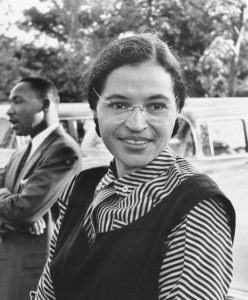
Although the stories and lives of the leaders of the civil rights movement are centered in popular representations, this grassroots mass movement was composed of working class African American men and women, White and African American students, and clergy that utilized the tactics of non-violent direct action (e.g., sit-ins, marches, and vigils) to demand full legal equality for African Americans in US society. For example, Rosa Parks—famous for refusing to give up her seat at the front of a Montgomery bus to a White passenger in December, 1955 and beginning the Montgomery Bus Boycott—was not acting as an isolated, frustrated woman when she refused to give up her seat at the front of the bus (as the typical narrative goes).
According to feminist historians Ellen Debois and Lynn Dumenil, Parks “had been active in the local NAACP for fifteen years, and her decision to make this stand against segregation was part of a lifelong commitment to racial justice. For some time NAACP leaders had wanted to find a good test case to challenge Montgomery’s bus segregation in courts.”[14] Furthermore, the bus boycott that ensued after Parks’ arrest and lasted for 381 days, until its success, was an organized political action involving both working-class African American and White women activists. The working-class Black women who relied on public transportation to go to their jobs as domestic servants in White households refused to use the bus system, and either walked to work or relied on rides to work from a carpool organized by women activists. Furthermore, the Women’s Political Caucus of Montgomery distributed fliers promoting the boycott and had provided the groundwork and planning to execute the boycott before it began.
Additionally, the sit-in movement was sparked by the Greensboro sit-ins, when four African American students in Greensboro, North Carolina, sat at and refused to leave a segregated lunch counter at a Woolworth’s store in February of 1960. The number of students participating in the sit-ins increased as the days and weeks went on, and the sit-ins began to receive national media attention. Networks of student activists began sharing the successes of the tactic of the nonviolent sit-in, and began doing sit-ins in their own cities and towns around the country throughout the early 1960s.
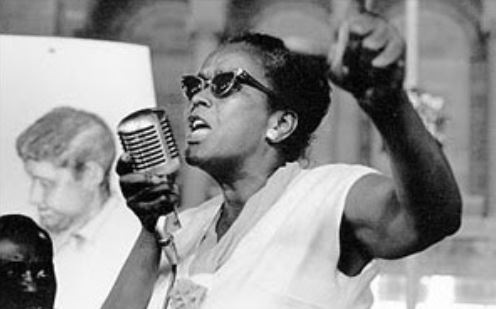
Importantly, the sit-in movement led to the formation of the Student Non-Violent Coordinating Committee (SNCC), initiated by Ella Baker shortly after the first sit-in strikes in Greensboro. The student activists of SNCC took part in the Freedom Rides of 1961, with African American and White men and women participants, and sought to challenge the Jim Crow laws of the south, which the Interstate Commerce Commission had ruled to be unconstitutional. The freedom riders experienced brutal mob violence in Birmingham and were jailed, but the Congress of Racial Equality (CORE) and SNCC kept sending riders to fill the jails of Birmingham. SNCC also participated in Freedom Summer in 1964, which was a campaign that brought mostly White students from the north down to the south to support the work of Black southern civil rights activists for voting rights for African Americans. Once again, Freedom Summer activists faced mob violence, but succeeded in bringing national attention to southern states’ foot-dragging in terms of allowing African Americans the legal rights they had won through activism and grassroots organizing.
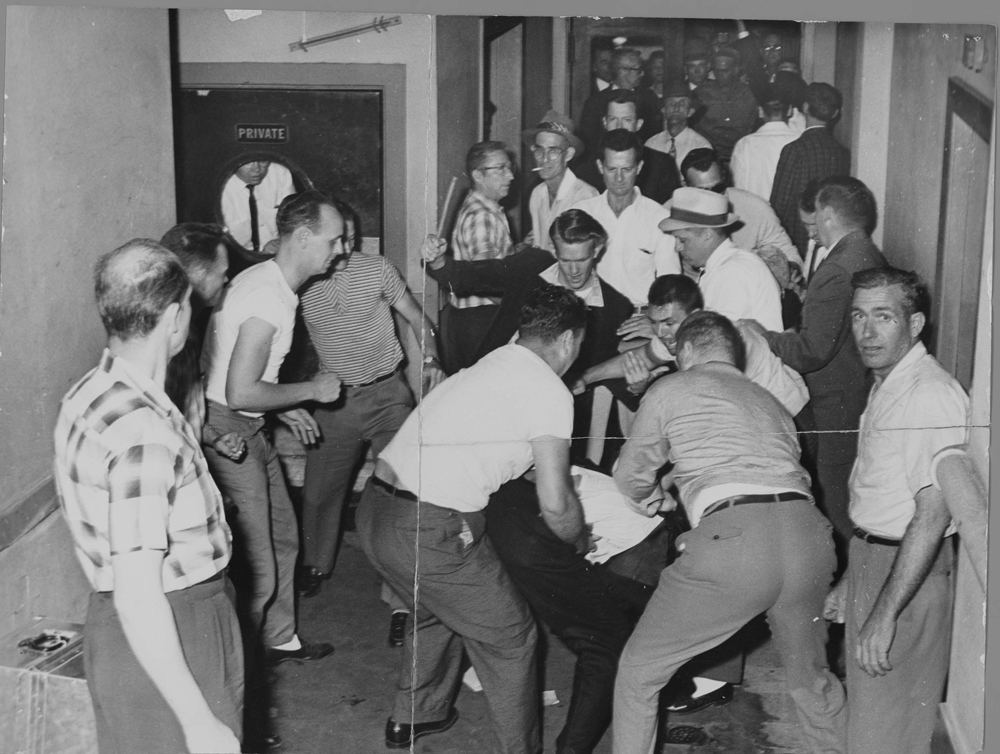
SNCC’s non-hierarchical structure gave women chances to participate in the civil rights movement in ways previously blocked to them. However, the deeply embedded sexism of the surrounding culture still seeped into civil rights organizations, including SNCC. Although women played pivotal roles as organizers and activists throughout the civil rights movement, men occupied the majority of formal leadership roles in the Southern Christian Leadership Council (SCLC), the NAACP, and CORE. Working with SNCC, Black women activists such as Fannie Lou Hamer and Diane Nash became noted activists and leaders within the civil rights movement in the early 1960s. Despite this, women within SNCC were often expected to do “women’s work” (i.e., housework and secretarial work). White women SNCC activists Casey Hayden and Mary King critiqued this reproduction of gendered roles within the movement and called for dialogue about sexism within the civil rights movement in a memo that circulated through SNCC in 1965, titled “Sex and Caste: A Kind of Memo.” The memo became an influential document for the birth of the second wave feminist movement, a movement focused generally on fighting patriarchal structures of power, and specifically on combating occupational sex segregation in employment and fighting for reproductive rights for women. However, this was not the only source of second wave feminism, and White women were not the only women spearheading feminist movements. As historian Becky Thompson[15] argues, in the mid and late 1960s, Latina women, African American women, and Asian American women were developing multiracial feminist organizations that would become important players within the U.S. second wave feminist movement.
In many ways, the second wave feminist movement was influenced and facilitated by the activist tools provided by the civil rights movement. Drawing on the stories of women who participated in the civil rights movement, historians Ellen Debois and Lynn Dumenil[16] argue that women’s participation in the civil rights movement allowed them to challenge gender norms that held that women belonged in the private sphere, and not in politics or activism. Not only did many women who were involved in the civil rights movement become activists in the second wave feminist movement, they also employed tactics that the civil rights movement had used, including marches and non-violent direct action. Additionally, the Civil Rights Act of 1964—a major legal victory for the civil rights movement—not only prohibited employment discrimination based on race, but Title VII of the Act also prohibited sex discrimination. When the Equal Employment Opportunity Commission (EEOC)—the federal agency created to enforce Title VII—largely ignored women’s complaints of employment discrimination, 15 women and one man organized to form the National Organization of Women (NOW), which was modeled after the NAACP. NOW focused its attention and organizing on passage of the Equal Rights Amendment (ERA), fighting sex discrimination in education, and defending Roe v. Wade—the Supreme Court decision of 1973 that struck down state laws that prohibited abortion within the first three months of pregnancy.
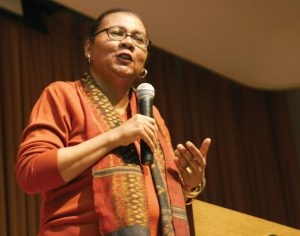
Although the second wave feminist movement challenged gendered inequalities and brought women’s issues to the forefront of national politics in the late 1960s and 1970s, the movement also reproduced race and sex inequalities. Black women writers and activists such as Alice Walker, bell hooks, and Patricia Hill Collins developed Black feminist thought as a critique of the ways in which second wave feminists often ignored racism and class oppression and how they uniquely impact women and men of color and working-class people. One of the first formal Black feminist organizations was the Combahee River Collective, formed in 1974. Black feminist bell hooks[17] argued that feminism cannot just be a fight to make women equal with men, because such a fight does not acknowledge that all men are not equal in a capitalist, racist, and homophobic society. Thus, hooks and other Black feminists argued that sexism cannot be separated from racism, classism and homophobia, and that these systems of domination overlap and reinforce each other. Therefore, she argued, you cannot fight sexism without fighting racism, classism, and homophobia. Importantly, Black feminism argues that an intersectional perspective that makes visible and critiques multiple sources of oppression and inequality also inspires coalitional activism that brings people together across race, class, gender, and sexual identity lines.
Third Wave and Queer Feminist Movements
“We are living in a world for which old forms of activism are not enough and today’s activism is about creating coalitions between communities.”
—Angela Davis, cited by Hernandez and Rehman in Colonize This!
Third wave feminism is, in many ways, a hybrid creature. It is influenced by second wave feminism, Black feminisms, transnational feminisms, Global South feminisms, and queer feminism. This hybridity of third wave activism comes directly out of the experiences of feminists in the late 20th and early 21st centuries who have grown up in a world that supposedly does not need social movements because “equal rights” for racial minorities, sexual minorities, and women have been guaranteed by law in most countries. The gap between law and reality—between the abstract proclamations of states and concrete lived experience—however, reveals the necessity of both old and new forms of activism. In a country where women are paid only 81% of what men are paid for the same labor,[18] where police violence in Black communities occurs at much higher rates than in other communities, where 58% of transgender people surveyed experienced mistreatment from police officers in the past year,[19] where 40% of homeless youth organizations’ clientele are gay, lesbian, bisexual, or transgender,[20] where people of color—on average—make less income and have considerably lower amounts of wealth than White people, and where the military is the most funded institution by the government, feminists have increasingly realized that a coalitional politics that organizes with other groups based on their shared (but differing) experiences of oppression, rather than their specific identity, is absolutely necessary. Thus, Leslie Heywood and Jennifer Drake argue that a crucial goal for the third wave is “the development of modes of thinking that can come to terms with the multiple, constantly shifting bases of oppression in relation to the multiple, interpenetrating axes of identity, and the creation of a coalitional politics based on these understandings.”[21]
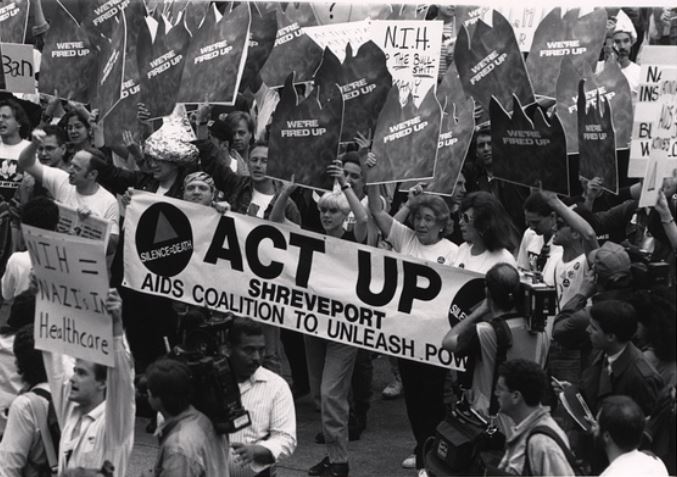
In the 1980s and 1990s, third wave feminists took up activism in a number of forms. Beginning in the mid 1980s, the AIDS Coalition to Unleash Power (ACT UP) began organizing to press an unwilling US government and medical establishment to develop affordable drugs for people with HIV/AIDS. In the latter part of the 1980s, a more radical subset of individuals began to articulate a queer politics, explicitly reclaiming a derogatory term often used against gay men and lesbians, and distancing themselves from the gay and lesbian rights movement, which they felt mainly reflected the interests of White, middle-class gay men and lesbians. As discussed at the beginning of this text, queer also described anti-categorical sexualities. The queer turn sought to develop more radical political perspectives and more inclusive sexual cultures and communities, which aimed to welcome and support transgender and gender non-conforming people and people of color. This was motivated by an intersectional critique of the existing hierarchies within sexual liberation movements, which marginalized individuals within already sexually marginalized groups. In this vein, Lisa Duggan[22] coined the term homonormativity, which describes the normalization and depoliticization of gay men and lesbians through their assimilation into capitalist economic systems and domesticity—individuals who were previously constructed as “other.” These individuals thus gained entrance into social life at the expense and continued marginalization of queers who were non-White, disabled, trans, single or non-monogamous, middle-class, or non-western. Critiques of homonormativity were also critiques of gay identity politics, which left out concerns of many gay individuals who were marginalized within gay groups. Akin to homonormativity, Jasbir Puar coined the term homonationalism, which describes the White nationalism taken up by queers, which sustains racist and xenophobic discourses by constructing immigrants, especially Muslims, as homophobic.[23] Identity politics refers to organizing politically around the experiences and needs of people who share a particular identity. The move from political association with others who share a particular identity to political association with those who have differing identities, but share similar, but differing experiences of oppression (coalitional politics), can be said to be a defining characteristic of the third wave.
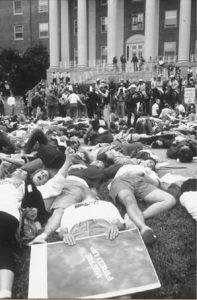
Another defining characteristic of the third wave is the development of new tactics to politicize feminist issues and demands. For instance, ACT UP began to use powerful street theater that brought the death and suffering of people with HIV/AIDS to the streets and to the politicians and pharmaceutical companies that did not seem to care that thousands and thousands of people were dying. They staged die-ins, inflated massive condoms, and occupied politicians’ and pharmaceutical executives’ offices. Their confrontational tactics would be emulated and picked up by anti-globalization activists and the radical Left throughout the 1990s and early 2000s. Queer Nation was formed in 1990 by ACT UP activists, and used the tactics developed by ACT UP in order to challenge homophobic violence and heterosexism in mainstream US society.
Around the same time as ACT UP was beginning to organize in the mid-1980s, sex-positive feminism came into currency among feminist activists and theorists. Amidst what is known now as the “Feminist Sex Wars” of the 1980s, sex-positive feminists argued that sexual liberation, within a sex-positive culture that values consent between partners, would liberate not only women, but also men. Drawing from a social constructionist perspective, sex-positive feminists such as cultural anthropologist Gayle Rubin[24] argued that no sexual act has an inherent meaning, and that not all sex, or all representations of sex, were inherently degrading to women. In fact, they argued, sexual politics and sexual liberation are key sites of struggle for White women, women of color, gay men, lesbians, queers, and transgender people—groups of people who have historically been stigmatized for their sexual identities or sexual practices. Therefore, a key aspect of queer and feminist subcultures is to create sex-positive spaces and communities that not only valorize sexualities that are often stigmatized in the broader culture, but also place sexual consent at the center of sex-positive spaces and communities. Part of this project of creating sex-positive, feminist and queer spaces is creating media messaging that attempts to both consolidate feminist communities and create knowledge from and for oppressed groups.
In a media-savvy generation, it is not surprising that cultural production is a main avenue of activism taken by contemporary activists. Although some commentators have deemed the third wave to be “post-feminist” or “not feminist” because it often does not utilize the activist forms (e.g., marches, vigils, and policy change) of the second wave movement,[25] the creation of alternative forms of culture in the face of a massive corporate media industry can be understood as quite political. For example, the Riot Grrrl movement, based in the Pacific Northwest of the US in the early 1990s, consisted of do-it-yourself bands predominantly composed of women, the creation of independent record labels, feminist ‘zines, and art. Their lyrics often addressed gendered sexual violence, sexual liberationism, heteronormativity, gender normativity, police brutality, and war. Feminist news websites and magazines have also become important sources of feminist analysis on current events and issues. Magazines such as Bitch and Ms., as well as online blog collectives such as Feministing and the Feminist Wire function as alternative sources of feminist knowledge production. If we consider the creation of lives on our own terms and the struggle for autonomy as fundamental feminist acts of resistance, then creating alternative culture on our own terms should be considered a feminist act of resistance as well.
As we have mentioned earlier, feminist activism and theorizing by people outside the US context has broadened the feminist frameworks for analysis and action. In a world characterized by global capitalism, transnational immigration, and a history of colonialism that has still has effects today, transnational feminism is a body of theory and activism that highlights the connections between sexism, racism, classism, and imperialism. In “Under Western Eyes,” an article by transnational feminist theorist Chandra Talpade Mohanty,[26] Mohanty critiques the way in which much feminist activism and theory has been created from a White, North American standpoint that has often exoticized “3rd world” women or ignored the needs and political situations of women in the Global South. Transnational feminists argue that Western feminist projects to “save” women in another region do not actually liberate these women, since this approach constructs the women as passive victims devoid of agency to save themselves. These “saving” projects are especially problematic when they are accompanied by Western military intervention. For instance, in the war on Afghanistan, begun shortly after 9/11 in 2001, U.S. military leaders and George Bush often claimed to be waging the war to “save” Afghani women from their patriarchal and domineering men. This crucially ignores the role of the West—and the US in particular—in supporting Islamic fundamentalist regimes in the 1980s. Furthermore, it positions women in Afghanistan as passive victims in need of Western intervention—in a way strikingly similar to the victimizing rhetoric often used to talk about “victims” of gendered violence (discussed in an earlier section). Therefore, transnational feminists challenge the notion—held by many feminists in the West—that any area of the world is inherently more patriarchal or sexist than the West because of its culture or religion through arguing that we need to understand how Western imperialism, global capitalism, militarism, sexism, and racism have created conditions of inequality for women around the world.
In conclusion, third wave feminism is a vibrant mix of differing activist and theoretical traditions. Third wave feminism’s insistence on grappling with multiple points-of-view, as well as its persistent refusal to be pinned down as representing just one group of people or one perspective, may be its greatest strong point. Similar to how queer activists and theorists have insisted that “queer” is and should be open-ended and never set to mean one thing, third wave feminism’s complexity, nuance, and adaptability become assets in a world marked by rapidly shifting political situations. The third wave’s insistence on coalitional politics as an alternative to identity-based politics is a crucial project in a world that is marked by fluid, multiple, overlapping inequalities.
This unit has developed a relational analysis of feminist social movements, from the first wave to the third wave, while understanding the limitations of categorizing resistance efforts within an oversimplified framework of three distinct “waves.” With such a relational lens, we are better situated to understand how the tactics and activities of one social movement can influence others. This lens also facilitates an understanding of how racialized, gendered, and classed exclusions and privileges lead to the splintering of social movements and social movement organizations. This type of intersectional analysis is at the heart not only of feminist activism but of feminist scholarship. The vibrancy and longevity of feminist movements might even be attributed to this intersectional reflexivity—or, the critique of race, class, and gender dynamics in feminist movements. The emphasis on coalitional politics and making connections between several movements is another crucial contribution of feminist activism and scholarship. In the 21st century, feminist movements confront an array of structures of power: global capitalism, the prison system, war, racism, ableism, heterosexism, and transphobia, among others. What kind of world do we wish to create and live in? What alliances and coalitions will be necessary to challenge these structures of power? How do feminists, queers, people of color, trans people, disabled people, and working-class people go about challenging these structures of power? These are among some of the questions that feminist activists are grappling with now, and their actions point toward a deepening commitment to an intersectional politics of social justice and praxis.
Licenses and Attributions
Open Content, Shared Previously
“Social movements” is adapted from “Understanding Social Movements” in Sociology by anonymous. License: CC BY-NC-SA 4.0. Adaptations: Edited for brevity and clarity.
“Introduction: Feminist movements” is from “Historical and Contemporary Feminist Social Movements” in Introduction to Women, Gender, Sexuality Studies by Miliann Kang, Donovan Lessard, Laura Heston, Sonny Nordmarken. License: CC BY 4.0.
Figure 7.18. “Clampdown, We are the 99%” by Glenn Halog. License: CC BY-NC 2.0.
Figure 7.19. “Votes for Women’ sellers, 1908” by LSE Library. Public domain.
Figure 7.20. “Ida B. Wells Barnett” by Mary Garrity. Public domain.
Figure 7.21. “Photograph of Rosa Parks with Dr. Martin Luther King jr. (ca. 1955)” by USIA. Public domain.
Figure 7.22. “Ella Baker” by The Ella Baker Center for Human Rights. License: CC BY 3.0
Figure 7.23. “Freedom Riders attacked” by Tommy Langston, Birmingham Post-Herald/FBI. Public domain.
Figure 7.24. “bell hooks” by Cmongirl. Public domain.
Figure 7.25. “ACT UP Demonstration at NIH” by NIH History Office. Public domain.
Figure 7.26. “ACT UP Demonstration on the lawn of Building 1” by NIH History Office. Public domain.
- Gamson, W. A. (1990). The strategy of social protest (2nd ed.). Wadsworth. ↵
- Snow, D. A., & Soule, S. A. (2010). A primer on social movements. W. W. Norton. ↵
- US Census. (2020, April 29). Age and sex composition in the United States: 2019 [table]. Retrieved August 6, 2020, from https://www.census.gov/data/tables/2019/demo/age-and-sex/2019-age-sex-composition.html ↵
- As quoted in Davis, A. (1981). Working women, Black women and the history of the suffrage movement, in A. Avakian and A. Deschamps (Eds.) A Transdisciplinary Introduction to Women’s Studies (pp. 73-78). Kendall/Hunt Publishing Company, p. 73. ↵
- Davis, A. (1981). Working women, Black women and the history of the suffrage movement, in A. Avakian and A. Deschamps (Eds.) A Transdisciplinary Introduction to Women’s Studies (pp. 73-78). Kendall/Hunt Publishing Company, pp. 74-75. ↵
- Cott, N. (2000). Public vows: A History of marriage and the nation. Harvard University Press. ↵
- As quoted in Cott, N. (2000). Public vows: A History of marriage and the nation. Harvard University Press, p. 64. ↵
- Davis, A. (1983). Women, race, class. Random House. ↵
- Painter, N. (1996). Sojourner Truth: A life, a symbol. W.W. Norton. ↵
- Wells, I. B. (1893). Lynch law. https://digital.library.upenn.edu/women/wells/exposition/exposition.html#IV ↵
- Zinn, H. (2003). A people’s history of the United States: 1492-present. HarperCollins. ↵
- Odo, F. (2017). How a segregated regiment of Japanese Americans became one of WWII’s most decorated. New America.https://www.newamerica.org/weekly/edition-150/how-segregated-regiment-japanese-americans-became-one-wwiis-most-decorated/ ↵
- Takaki, R. (2001). Double victory: A multicultural history of America in World War II. Back Bay Books. ↵
- Debois, E. & Dumenil, L. (2005). Through women’s eyes: An American history with documents. St. Martin Press, p. 576. ↵
- Thompson, B. (2002). Multiracial feminism: Recasting the chronology of second wave feminism, Feminist Studies 28(2): 337-360. ↵
- Debois, E. & Dumenil, L. (2005). Through women’s eyes: An American history with documents. St. Martin Press. ↵
- hooks, b. (1984). Feminist theory: From margin to center (2nd ed.). South End Press. ↵
- Bureau of Labor Statistics. (2019, November). Highlights of women’s earnings in 2018. https://www.bls.gov/opub/reports/womens-earnings/2018/home.htm ↵
- James, S. E., Herman, J. L., Rankin, S., Keisling, M., Mottet, L., & Ana , M. (2016). The report of the 2015 U.S. transgender survey. National Center for Transgender Equality. https://www.transequality.org/sites/default/files/docs/USTS-Full-Report-FINAL.PDF ↵
- Durso, L.E., & Gates, G.J. (2012). Serving Our youth: Findings from a national survey of service providers working with lesbian, gay, bisexual, and transgender youth who are homeless or at risk of becoming homeless. The Williams Institute with True Colors Fund and The Palette Fund. https://escholarship.org/uc/item/80x75033 ↵
- Heywood, L. and J. Drake. (1997). Third wave agenda: Being feminist, doing feminism. University of Minnesota Press, p. 3. ↵
- Duggan, L. (2002). The new homonormativity: The sexual politics of neoliberalism. In R. Castronovo & D. Nelson (Eds.), Materializing democracy (pp. 175-194). Duke University Press. ↵
- Puar, J. (2007). Terrorist assemblages: Homonationalism in queer times. Duke University Press. ↵
- Rubin, G. (1984). Thinking sex: Notes for a radical theory of the politics of sexuality. In C. Vance, (Ed)., Pleasure and danger. Routledge ↵
- Sommers, C. H. (1994). Who stole feminism? How women have betrayed women. Doubleday. ↵
- Mohanty, C. T. (1991). Under western eyes: Feminist scholarship and colonial discourses. In d. C. T. Mohanty, A. Russo, & L. Torres (Eds.), Third world women and the politics of feminism. Indiana University Press ↵
A person’s sense of self as defined by and in relation to the combination of social characteristics, roles, and groups to which they belong.
Everyone having access to what they need.
Ensuring that people have what they need in order to have a healthy, successful life equal to others. Different from equality in that some may receive more help than others in order to be at the same level of success.
Describes traits that may be biologically determined and/or socially constructed. Examples include sex, gender, race, ethnicity, ability, age, sexuality, nationality, first language, and religion.
A social category and shared identity based on a common culture or national sense of belonging.
An identity that typically describes a woman who is attracted to other women.
A socially transmitted worldview created, learned and shared by a group which includes values, beliefs, customs and behaviors and which is reflected in language, objects, food, and social institutions.
An identity that describes someone who is homosexual, i.e. attracted to others of their same gender. Used to refer to men who are attracted to other men, but also used as an umbrella term that includes anyone who is attracted to their own gender.
An identity that describes a person who holds a gender identity that is different from the one they were assigned at birth.

